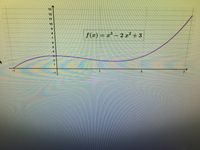
Advanced Engineering Mathematics
10th Edition
ISBN: 9780470458365
Author: Erwin Kreyszig
Publisher: Wiley, John & Sons, Incorporated
expand_more
expand_more
format_list_bulleted
Concept explainers
Question

Transcribed Image Text:The image is a graph of the function \( f(x) = x^3 - 2x^2 + 3 \).
### Graph Details:
- **Axes:** The graph contains a vertical axis (y-axis) and a horizontal axis (x-axis). Both axes are clearly labeled with increments.
- **Curve:** The function is represented by a smooth purple curve.
- **Behavior:**
- The curve starts from the left, decreasing slightly and then increasing as it moves from \( x = -1 \) to \( x = 3 \).
- The graph demonstrates a point of inflection near the origin, where the concavity changes.
- As \( x \) increases, the curve rises steeply beyond \( x = 2 \).
### Function Characteristics:
- **Equation:** \( f(x) = x^3 - 2x^2 + 3 \)
- **Type:** Cubic polynomial
- **General Form:** The equation is in the standard form of a cubic function: \( ax^3 + bx^2 + cx + d \), where \( a = 1 \), \( b = -2 \), \( c = 0 \), and \( d = 3 \).
The graph visually represents how the cubic function behaves across the given range, capturing changes in direction and inflection points to illustrate polynomial growth.
![### Approximating the Integral of a Function Using Midpoint Sums
#### Problem Statement:
a) Given the following graph of \( f(x) = x^3 - 2x^2 + 3 \) on the interval \([-1, 3]\). Approximate \( \int_{-1}^{3} f(x) \, dx \) by using the midpoint sums where \( n = 4 \). Shade the area that represents the midpoint sums.
b) Find the absolute error for using the midpoint sums.
(Recall: Absolute error = | True value - Approximation |)
#### Explanation:
- **Midpoint Rule:**
- Divide the interval \([-1, 3]\) into 4 equal subintervals.
- Identify the midpoint of each subinterval.
- Calculate the area of rectangles using these midpoints and sum them up for an approximation of the integral.
- **Absolute Error:**
- Determine the true value of the integral.
- Subtract the approximated value from the true value.
- Take the absolute value of the result to find the absolute error.
This exercise helps in understanding numerical integration techniques and error analysis.](https://content.bartleby.com/qna-images/question/f2ce945b-ebf8-47d5-81d6-18edb03d27a8/3c2f930e-f930-4d48-abd3-185a5b44e079/epgcle_thumbnail.jpeg)
Transcribed Image Text:### Approximating the Integral of a Function Using Midpoint Sums
#### Problem Statement:
a) Given the following graph of \( f(x) = x^3 - 2x^2 + 3 \) on the interval \([-1, 3]\). Approximate \( \int_{-1}^{3} f(x) \, dx \) by using the midpoint sums where \( n = 4 \). Shade the area that represents the midpoint sums.
b) Find the absolute error for using the midpoint sums.
(Recall: Absolute error = | True value - Approximation |)
#### Explanation:
- **Midpoint Rule:**
- Divide the interval \([-1, 3]\) into 4 equal subintervals.
- Identify the midpoint of each subinterval.
- Calculate the area of rectangles using these midpoints and sum them up for an approximation of the integral.
- **Absolute Error:**
- Determine the true value of the integral.
- Subtract the approximated value from the true value.
- Take the absolute value of the result to find the absolute error.
This exercise helps in understanding numerical integration techniques and error analysis.
Expert Solution
This question has been solved!
Explore an expertly crafted, step-by-step solution for a thorough understanding of key concepts.
This is a popular solution
Trending nowThis is a popular solution!
Step by stepSolved in 2 steps with 1 images

Knowledge Booster
Learn more about
Need a deep-dive on the concept behind this application? Look no further. Learn more about this topic, advanced-math and related others by exploring similar questions and additional content below.Similar questions
Recommended textbooks for you
 Advanced Engineering MathematicsAdvanced MathISBN:9780470458365Author:Erwin KreyszigPublisher:Wiley, John & Sons, Incorporated
Advanced Engineering MathematicsAdvanced MathISBN:9780470458365Author:Erwin KreyszigPublisher:Wiley, John & Sons, Incorporated Numerical Methods for EngineersAdvanced MathISBN:9780073397924Author:Steven C. Chapra Dr., Raymond P. CanalePublisher:McGraw-Hill Education
Numerical Methods for EngineersAdvanced MathISBN:9780073397924Author:Steven C. Chapra Dr., Raymond P. CanalePublisher:McGraw-Hill Education Introductory Mathematics for Engineering Applicat...Advanced MathISBN:9781118141809Author:Nathan KlingbeilPublisher:WILEY
Introductory Mathematics for Engineering Applicat...Advanced MathISBN:9781118141809Author:Nathan KlingbeilPublisher:WILEY Mathematics For Machine TechnologyAdvanced MathISBN:9781337798310Author:Peterson, John.Publisher:Cengage Learning,
Mathematics For Machine TechnologyAdvanced MathISBN:9781337798310Author:Peterson, John.Publisher:Cengage Learning,


Advanced Engineering Mathematics
Advanced Math
ISBN:9780470458365
Author:Erwin Kreyszig
Publisher:Wiley, John & Sons, Incorporated

Numerical Methods for Engineers
Advanced Math
ISBN:9780073397924
Author:Steven C. Chapra Dr., Raymond P. Canale
Publisher:McGraw-Hill Education

Introductory Mathematics for Engineering Applicat...
Advanced Math
ISBN:9781118141809
Author:Nathan Klingbeil
Publisher:WILEY

Mathematics For Machine Technology
Advanced Math
ISBN:9781337798310
Author:Peterson, John.
Publisher:Cengage Learning,

